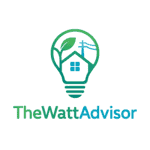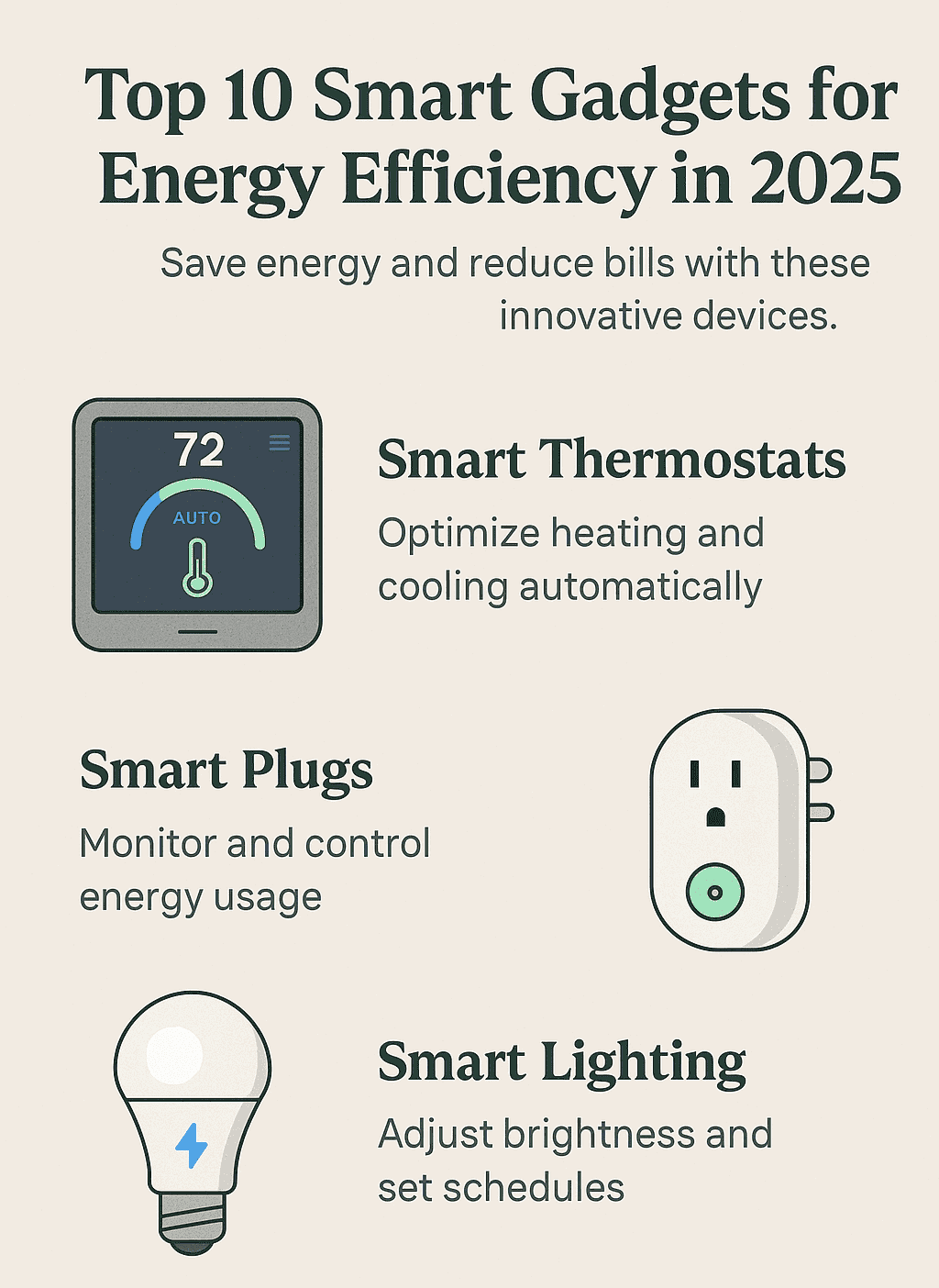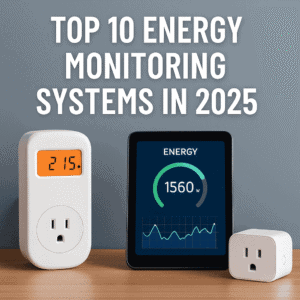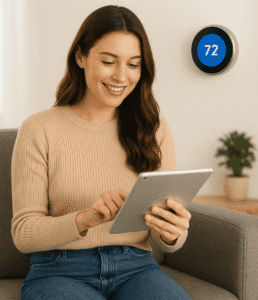Top 10 Smart Gadgets for Energy Efficiency in 2025
In 2025, saving energy isn’t just about turning off the lights — it’s about upgrading your home with smart gadgets for energy efficiency. From thermostats that learn your habits to plugs that shut off idle devices, the latest smart tech empowers homeowners to reduce consumption and cut utility bills effortlessly. This guide explores the top 10 smart gadgets for energy efficiency, helping you choose tools that offer real savings and long-term value. Whether you’re building a smart home or just starting out, these devices will make your space more efficient, intelligent, and eco-friendly.
Why Smart Gadgets Matter
As we enter 2025, smart gadgets aren’t just convenient—they’re essential tools for energy efficiency. Using connected devices like smart thermostats, light bulbs, plugs, and more—homeowners can save money, monitor usage, and reduce carbon footprints. This post will explore the top ten smart gadgets transforming how we manage and conserve energy at home. Each section includes benefits and actionable insights to maximize your savings while elevating comfort.
1. Smart Thermostats
Examples: Google Nest Learning Thermostat, ecobee Smart Thermostat Premium
Description
Smart thermostats automatically adjust heating and cooling schedules based on occupancy, learning patterns over time. They connect via Wi-Fi and offer remote control, geofencing, and energy usage insights through mobile apps. Modern models sync with voice assistants and provide monthly reports to guide savings.
Pros
- Save 10–20% on HVAC energy bills
- Remote control and smart scheduling
- Useful alerts (e.g., filter replacement)
Cons
- Higher upfront cost ($150–$250)
- Requires compatibility with HVAC systems
- Privacy concerns with data collection
Also Read: How Smart Thermostats Save You Money
2. Smart Thermostatic Radiator Valves (Smart TRVs)
Examples: Tado Smart Radiator Thermostat, Eve Thermo
Description
Smart TRVs replace traditional radiator valves, allowing room-by-room temperature control. They connect via Wi-Fi or Bluetooth to your central thermostat, sensing occupancy and adjusting heating zones individually.
Pros
- Precise zone-based heating control
- Easy to install with many radiator systems
- Compatible with HVAC installations
Cons
- Only applicable for radiator-based heating systems
- Requires multiple units for whole-home coverage
- Some models need a hub for full functionality
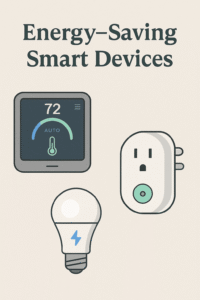
3. Smart LED Lighting Systems
Examples: Philips Hue, LIFX, Nanoleaf
Description
Smart LED bulbs allow you to schedule lighting, adjust color and brightness, and operate remotely. They can also integrate with occupancy sensors, automatically switching on or off. These LEDs use significantly less energy and offer customizable ambiance.
Pros
- Up to 75% energy savings vs. incandescent bulbs
- Scheduler and sensor integration
- Durable lifespan (~25,000+ hours)
Cons
- Higher price than standard LEDs
- Dependence on companion apps or hubs
- Connectivity issues in poorly maintained Wi-Fi
4. Smart Motion & Occupancy Sensors
Examples: Philips Hue Motion Sensor, Aqara Motion Sensor
Description
These sensors detect movement and trigger connected devices like lights, fans, or plugs. They eliminate wasted energy by automating on/off routines in unused areas like closets, hallways, and bathrooms.
Pros
- Reduces idle energy usage
- Extends bulb lifespan
- Enables automation without wearable devices
Cons
- False triggers (pets, drafts) can occur
- Batteries require replacement
- Coverage may be limited in larger spaces
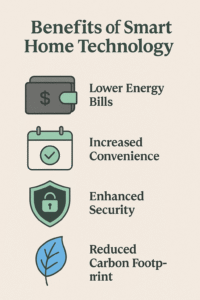
5. Smart Power Strips & Plugs
Examples: TP-Link Kasa HS300, Amazon Smart Plug
Description
Smart plugs and power strips allow remote control and scheduling of devices, and track energy usage. Advanced power strips can switch off “vampire” standby power, saving energy while idle devices aren’t needed.
Pros
- Easy and affordable energy control
- Offers usage tracking and automation
- Protects electronics from power spikes
Cons
- Some devices don’t support high-watt appliances
- Wi‑Fi reliability may vary
- Individual smart plugs can be cumbersome
6. Home Energy Monitoring Systems
Examples: Sense Home Energy Monitor, Emporia Vue
Description
These monitors install at your electrical panel and track energy usage per circuit in real-time. They help identify high-energy appliances, spikes, and inefficiencies—empowering smarter decisions and targeted upgrades.
Pros
- Precise identification of energy hogs
- Historical data for trend analysis
- Integration with HVAC and smart plugs
Cons
- Professional installation may be required
- Higher upfront cost (~$200–$300)
- Data quality depends on sensor calibration
7. Smart HVAC Dampers & Zone Controllers
Examples: Flair Smart Vent, Ecovent
Description
These devices control airflow in ducted HVAC systems by opening and closing vents per room. Paired with smart thermostats, they optimize HVAC use, focusing heating/cooling where needed.
Pros
- Improves zoned comfort
- Prevents energy wastage in unused spaces
- Syncs with occupancy sensors
Cons
- Complex ductwork installation
- Expensive when outfitting entire home
- Requires central integration for smart scheduling
8. Smart Water Heater Controllers
Examples: Rheem EcoNet Gateway, Flume 2
Description
Controllers like EcoNet let users schedule water heating, track hot-water use, and integrate with home energy systems. Monitoring flow and temperature prevents wasted energy and detects leaks early.
Pros
- Cuts water heating energy by 15–20%
- Leak detection protects against damage
- Works with off-peak billing strategies
Cons
- Compatibility limited by water-heater type
- Benefits vary with household usage
- Installation may require professional help
9. Solar-Connected Smart Inverters & Battery Systems
Examples: Enphase IQ, Tesla Powerwall
Description
These systems manage solar production and battery storage intelligently—automatically storing excess solar energy or drawing from grid depending on peak rates. Integrated apps enable optimization.
Pros
- Maximizes solar utilization
- Offers backup during outages
- Reduces peak-grid draw and bills
Cons
- High initial investment
- Requires solar panel installation
- Complex regulatory compliance needs
Also Read: Solar Panels vs Solar Roofs: Which is Better?
10. Smart Blinds & Shades
Examples: Lutron Serena Shades, IKEA FYRTUR
Description
Automated window treatments respond to sunlight, temperature, or scheduled times, helping regulate indoor climate. By controlling incoming heat, they reduce HVAC usage and improve comfort.
Pros
- Passive energy-saving tool
- Improves privacy and convenience
- Integrates with weather forecasts
Cons
- High installation cost
- Limited to compatible window shapes/sizes
- Motor reliability concerns
💡 Choosing the Right Smart Gadgets for Energy Efficiency
To prioritize investments:
- Start with HVAC: Smart thermostats and TRVs yield the largest savings.
- Add lighting: Smart LEDs are affordable and effective.
- Automate idle energy: Use smart plugs, motion sensors, and blinds.
- Scale up: Go for energy monitoring, HVAC dampers, water heaters, solar, and shades for deeper efficiency gains.
Consider your home’s current setup, budget, and whether you’re qualifying for rebates (especially for thermostats, HVAC, and solar systems).
Conclusion
As we move toward more sustainable living, investing in smart gadgets for energy efficiency is no longer optional — it’s essential. These innovative tools don’t just help reduce your energy bills; they also make your home more responsive and environmentally friendly. From smart thermostats to intelligent lighting and home energy monitors, every gadget on this list contributes to a smarter, greener lifestyle. By choosing the right smart gadgets for energy efficiency, you’re not just improving convenience — you’re making a long-term investment in your home and the planet. Start today, and see how the best smart gadgets for energy efficiency in 2025 can transform your energy habits for good.
What’s Next after choosing smart gadgets for energy efficiency
- Check rebates in your region for smart home devices
- Ensure Wi-Fi and smart-home platform compatibility (Alexa, Google, HomeKit)
- Combine smart gadgets with efficiency strategies like insulation, airtightness, and energy audits
- Other reads related to Top 10 Smart Gadgets for Energy Efficiency in 2025:
FAQs
Which smart gadget offers the best energy savings?
Smart thermostats typically deliver the highest energy savings by optimizing your home’s heating and cooling based on occupancy and usage patterns. Pairing them with thermostatic radiator valves (TRVs) amplifies their impact.
Can I use smart gadgets in any home?
Yes—most smart gadgets work in homes with Wi-Fi and compatible systems. Just ensure your HVAC, lighting, or solar setup is supported by the device you choose.
Do smart gadgets require a hub?
Some devices, like smart TRVs or lighting systems, may need a central hub. Others—like smart plugs or thermostats—connect directly to your home Wi-Fi network. Check product specs for specifications.
Are there rebates for smart energy gadgets?
Many utilities and governments offer rebates for smart thermostats, water heater controllers, and energy monitoring systems. Check local rebate database for current offers.
This Post was on Top 10 Smart Gadgets for Energy Efficiency in 2025.
